Key takeaways:
- Effective event timing is crucial for ensuring engagement and a positive experience for attendees, as poor timing can lead to frustration and diminished energy.
- Understanding the audience’s availability, seasonal trends, and logistics is vital for scheduling events that attract maximum participation.
- Incorporating buffer time and using shared scheduling tools can enhance collaboration and allow for organic networking opportunities.
- Clear communication about timing changes and a well-planned promotional timeline can significantly impact attendance and overall success of the event.
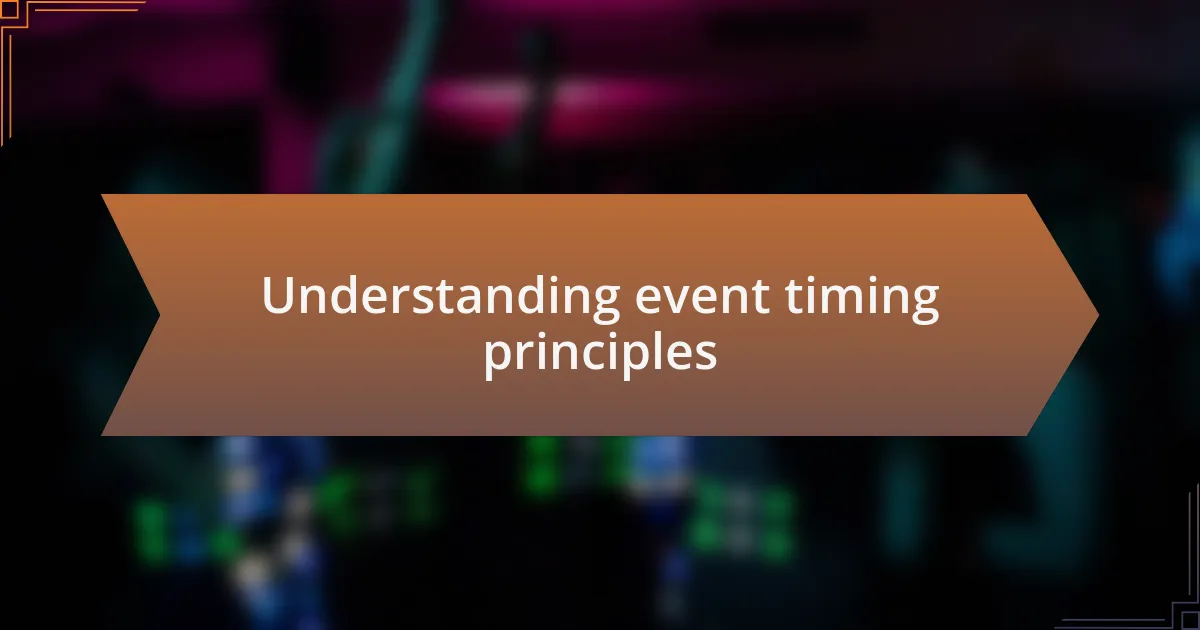
Understanding event timing principles
Understanding event timing principles is crucial for delivering a successful event. Think about it: when I first started organizing events, I overlooked the timing of various activities. I learned the hard way that an event can feel rushed or dragging if the timing isn’t precise, which can significantly impact the overall experience for attendees.
For instance, I’ve found that having a well-defined timeline not only keeps the event on track but also helps participants engage fully. Imagine a conference where sessions overlap or start late; frustration builds among attendees, and the energy in the room dissipates quickly. This taught me to respect time not just as a schedule but as a vital component of the attendees’ experience.
Moreover, aligning specific activities with attendees’ attention spans can greatly enhance engagement. When planning workshops, I’ve noticed that interactive sessions thrive in the morning when energy is high. Have you considered how the timing of breaks can invigorate or exhaust your audience? Adjusting your event schedule around these natural rhythms, I’ve seen creativity and enthusiasm flourish.
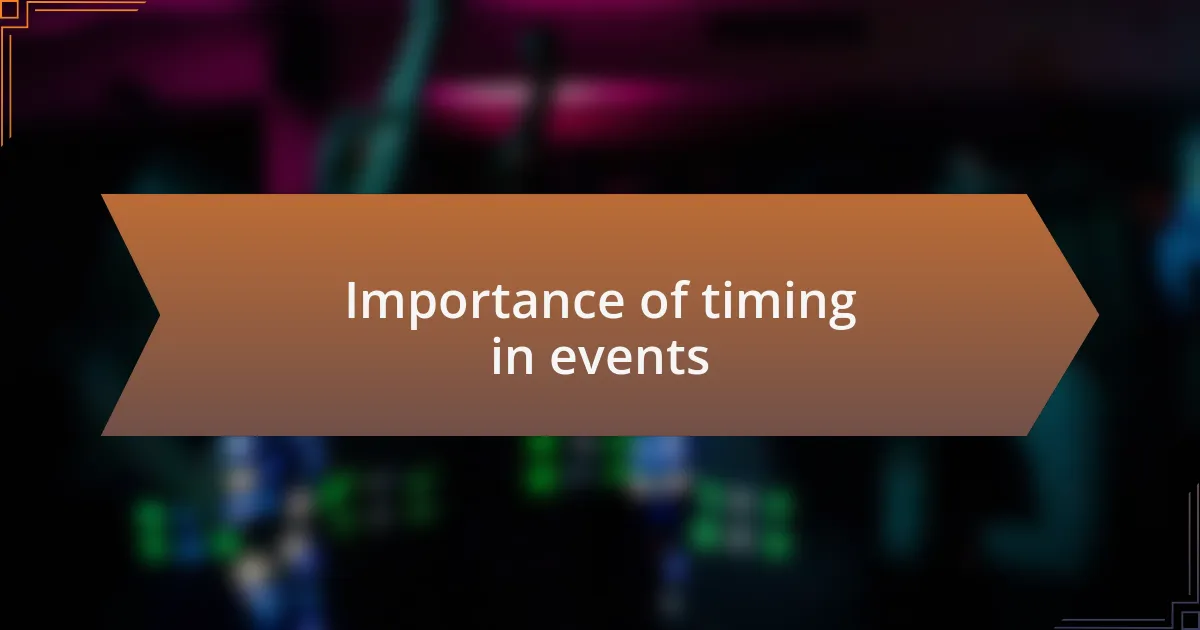
Importance of timing in events
Respecting timing in events is like conducting a fine orchestra. I remember planning a charity gala where the dinner was scheduled just after a lengthy keynote speech. The guests were restless and hungry, and the energy plummeted. This experience reinforced for me that timing isn’t just about following a schedule; it’s about creating a rhythm that keeps the atmosphere lively and enjoyable.
Another crucial aspect I’ve reflected on is timing during networking opportunities. Once, at a panel discussion, I misjudged the time allotted for audience questions. It cut into the valuable mingling time afterwards. I learned that providing sufficient time for networking not only builds connections but can also lead to unexpected collaborations. Isn’t it fascinating how simple adjustments can foster such a dynamic engagement?
I’ve also observed that the timing of promotional materials related to an event plays a vital role. For example, I’ve had events where I released promotional content too close to the event date, leading to lower attendance. By spacing out the announcements, I built anticipation and excitement, which ultimately drew a larger crowd. Have you thought about how your timing can influence not just the event itself but also its reach and effectiveness?
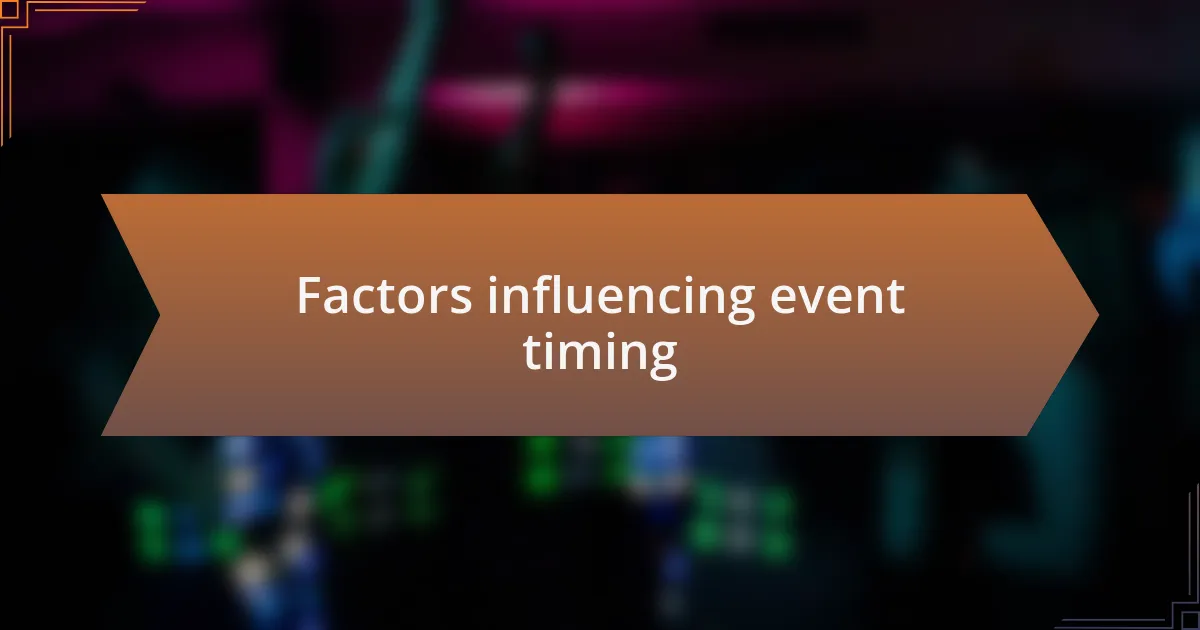
Factors influencing event timing
When considering the timing of an event, one major factor is the target audience. I recall planning a summer seminar where I chose a weekday afternoon, thinking it convenient. However, I soon realized that many potential attendees were still at work or attending to other commitments. This taught me to embrace the nuances of my audience’s schedule; it’s essential to choose a timeframe that aligns with their availability for maximum participation.
Another significant element influencing event timing is seasonal trends. I once organized a winter networking event, oblivious to the holiday rush. Attendance suffered, as people were overwhelmed with festivities and travel plans. This experience made me acutely aware of how seasons and holidays shape the priorities and schedules of participants. Have you ever thought about how a well-timed event can harmonize with the seasonal rhythm of your audience’s lives?
Lastly, logistics play a critical role in determining when an event unfolds. I remember a large conference that was meticulously timed around speaker availability. Yet, when a key speaker’s travel plans shifted, it set off a domino effect of delays and changes. This taught me that flexibility is invaluable in event timing. How often do we account for the unpredictable nature of logistics when we plan? I now prioritize contingencies, allowing me to pivot gracefully when challenges arise.
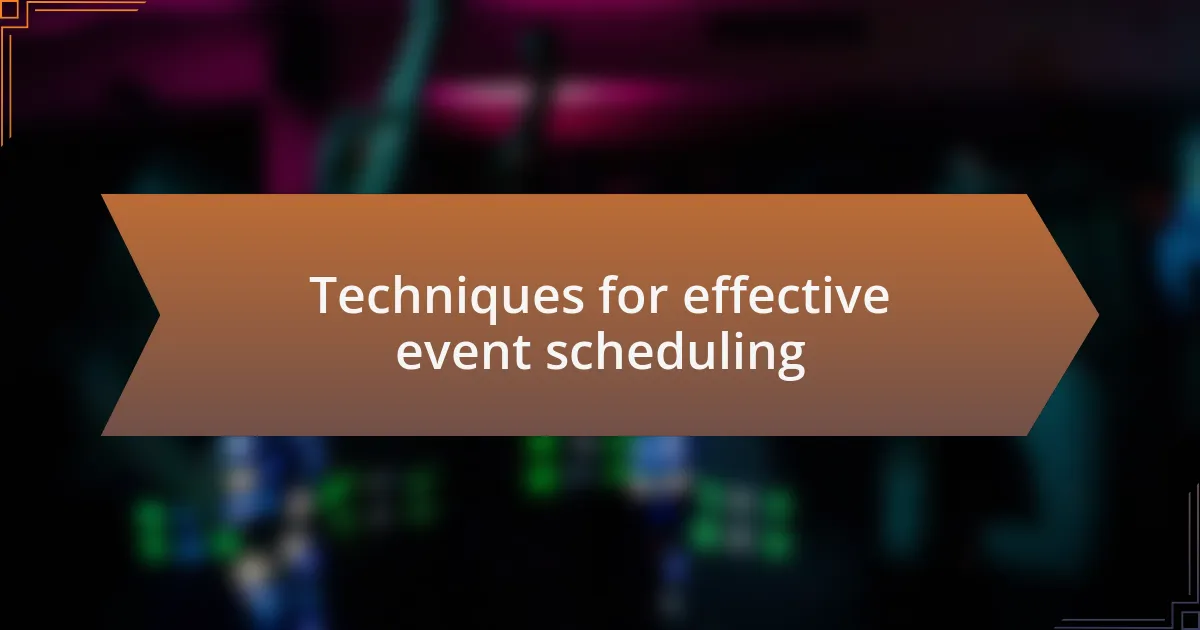
Techniques for effective event scheduling
One technique I’ve found invaluable in effective event scheduling is using a shared calendar tool. During my last corporate retreat, I integrated a platform that allowed team members to indicate their availability. This simple step transformed our planning process, enabling us to pinpoint a date that worked for the majority. Have you ever noticed how a quick poll can streamline decision-making? It not only fosters collaboration but also builds excitement as everyone feels included right from the start.
Another approach I utilize is the principle of buffer time. I learned this during a project launch event when I initially packed the schedule tight. Of course, things didn’t go as planned, leading to a rushed atmosphere. Adding buffer time between sessions allows for organic conversations and networking opportunities. Have you ever seen how great ideas can emerge spontaneously when people have a little breathing room? It’s often these unplanned moments that lead to the most fruitful connections.
Lastly, I advocate for early scheduling as a credible technique. I remember organizing a workshop with only a few weeks’ notice, and the struggle was real. Participants had already filled their calendars, and attendance was sparse. Planning events well in advance opens up more options and accommodates a wider audience. It’s a lesson learned—how often have you missed out on attending something you were interested in because it clashed with prior commitments? Taking the lead on timing allows you to attract the desired crowd and ensure a successful turnout.

My personal event timing strategies
One strategy that often works for me is aligning event timing with peak engagement periods. For instance, I once scheduled an industry seminar right after lunch, thinking it would be a convenient time. However, I quickly discovered that attendees were often sluggish and distracted post-meal. Since then, I prioritize morning or late-afternoon slots when energy levels are typically higher. Wouldn’t you agree that the right time can make a world of difference in audience enthusiasm?
I also believe in the power of thematic timing. There was a networking event I arranged around a major industry conference, and the synergy was incredible. Tapping into existing momentum not only increased attendance but also heightened excitement around the event. When timing aligns with broader industry happenings, it feels intentional and elevated. Have you ever attended an event that just seemed to resonate perfectly with the zeitgeist?
Finally, I find flexibility to be crucial. For one community event, I adjusted the start time based on feedback from potential attendees who had conflicting obligations. As we shifted the timing, not only did we see a spike in RSVPs, but the atmosphere of the event felt incredibly positive. Being adaptable can turn what might have been a mediocre turnout into a vibrant gathering. Isn’t it refreshing to witness how a simple timing tweak can amplify engagement?
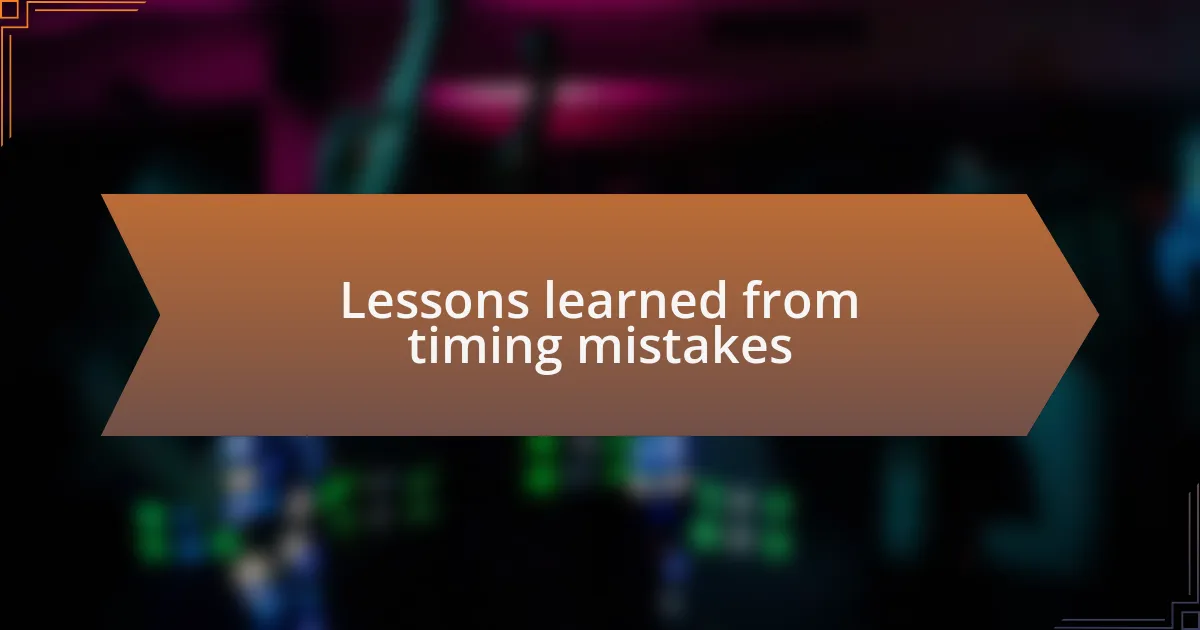
Lessons learned from timing mistakes
Timing errors in event management can teach invaluable lessons. I once scheduled a charity gala during the Super Bowl, thinking attendees would prioritize the cause over the game. The surprisingly low turnout made it clear: competing with a massive cultural event was a rookie mistake. Reflecting on that, I understand the importance of knowing the calendar. Have you ever overlooked a major event that affected your plans?
Another timing pitfall came when I organized an outdoor fest in the early fall without considering the unpredictability of the weather. It drizzled that day, and attendance plummeted. I learned firsthand that environmental factors must be factored into planning. Now, I check historical weather patterns before finalizing outdoor events — it’s a small step, but it has made a big difference. Have you ever faced unexpected weather at an event?
Lastly, I remember an instance where I overlooked notifying participants about a time change for a workshop. Only half the expected audience showed up, prompting a long day for a few eager attendees. This taught me the value of clear communication. I now set reminders and use multiple channels to ensure everyone is on the same page. Isn’t it amazing how a quick message can save both time and stress?
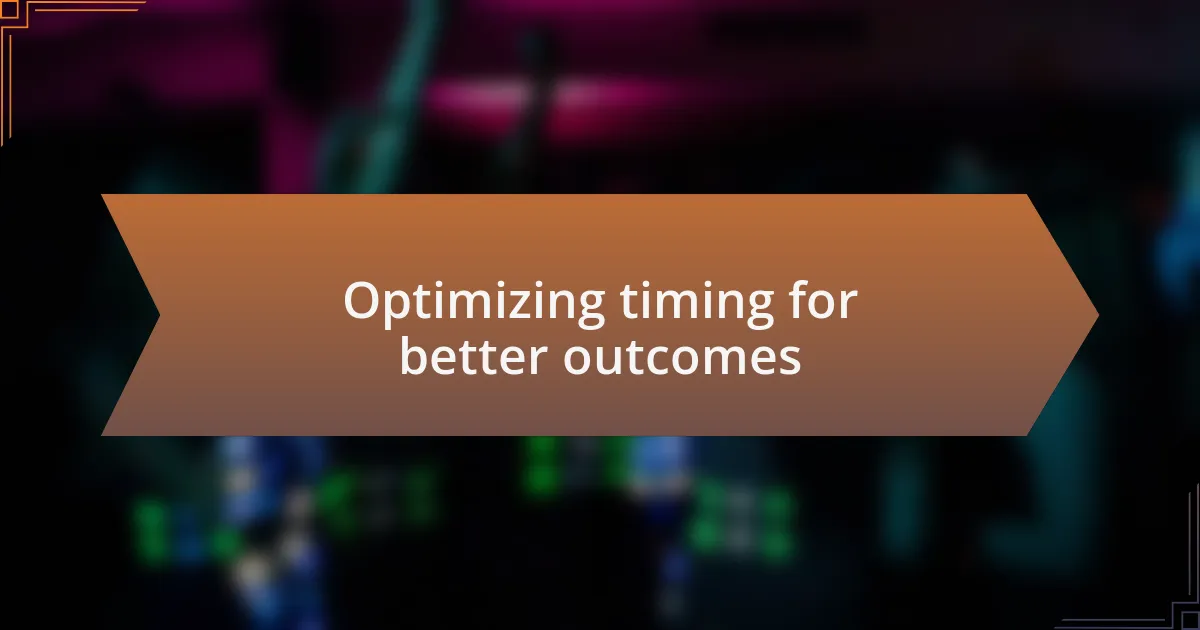
Optimizing timing for better outcomes
When it comes to optimizing timing for better outcomes, I’ve learned that aligning event schedules with participant availability can drastically impact attendance. I once hosted a workshop on a weekday afternoon, assuming that people would appreciate a break from their routines. Instead, I found that most attendees were tied up with work commitments. It made me realize the importance of analyzing when my audience is most receptive, whether it’s evenings or weekends. Have you ever thought about when your audience is most likely to engage?
Timing extends beyond just the date; it’s also about pacing during the event itself. I vividly remember a conference where we jam-packed the agenda with speakers, leaving little time for networking. Consequently, we lost the chance for meaningful interactions among participants. Since then, I’ve prioritized building in buffer periods for discussions, allowing attendees to digest information and connect. Doesn’t it feel more fulfilling when you have the space to exchange ideas?
Moreover, I’ve discovered that setting a clear timeline for event promotion is essential. When I underestimated how long it would take to spread the word, I paid the price with a half-filled venue. I now implement a promotional calendar that spans weeks, ensuring ample time for marketing efforts. This not only creates buzz but also boosts anticipation. Have you reflected on how your promotion timing influences turnout?